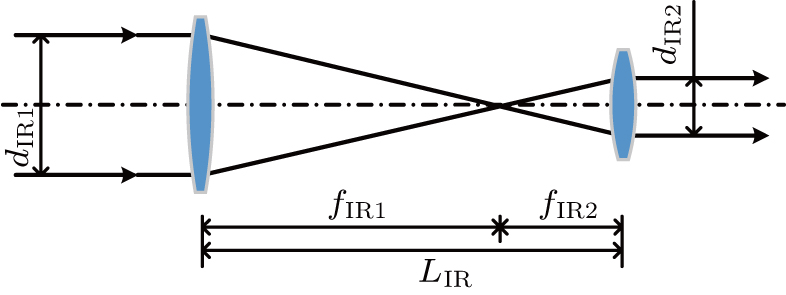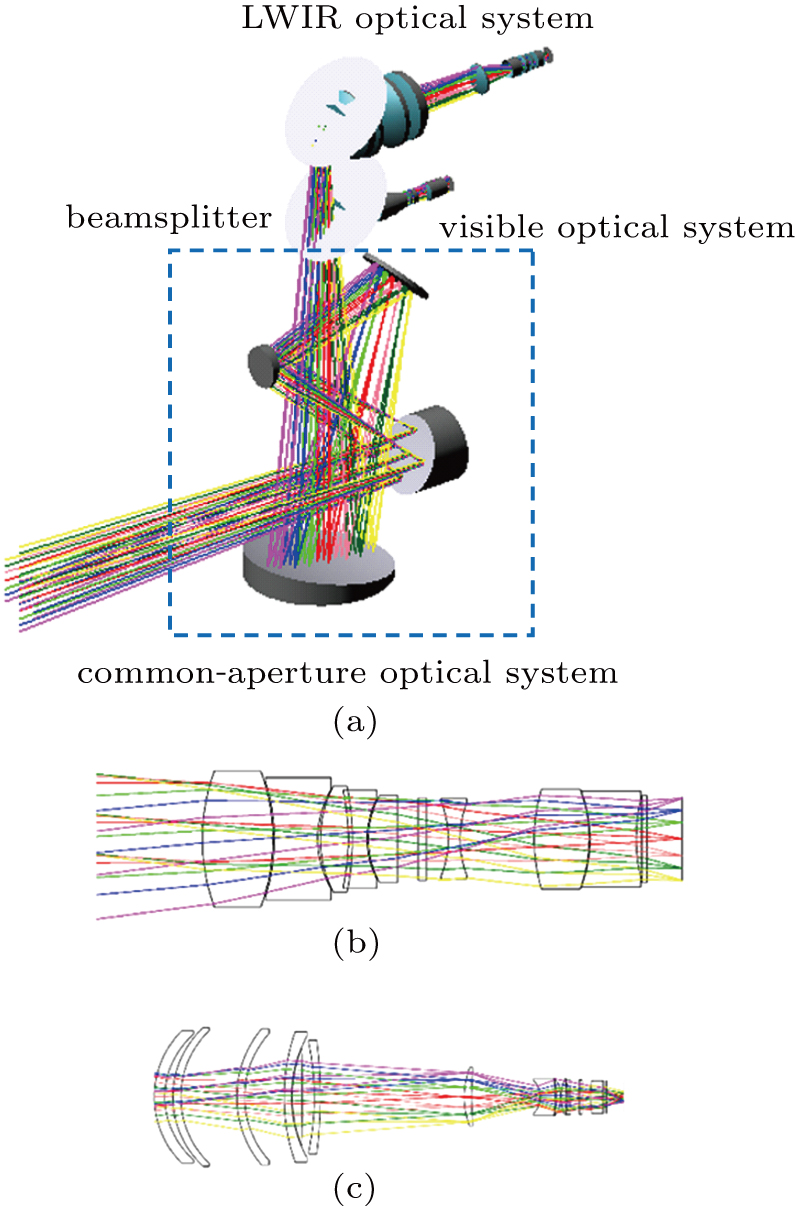† Corresponding author. E-mail:
Multispectral and polarization cameras that can simultaneously acquire the spatial, spectral, and polarization characteristics of an object have considerable potential applications in target detection, biomedical imaging, and remote sensing. In this work, we develop a common-aperture optical system that can capture multispectral and polarization information. An off-axis three-mirror optical system is mounted on the front end of the proposed system and used as a common-aperture telescope in the visible light (400 nm–750 nm) and long-wave infrared (LWIR, 
Spectral imaging detects two-dimensional (2D) spatial information about multiple wavelengths with two spatial coordinates and one spectral dimension.[1–7] Polarization imaging acquires the information about target’s features, shapes, texture, and material composition.[8–10] Multispectral and polarization imaging[11,12] can obtain the polarization information of an object in different wavelengths and thus becomes an effective detection technique[13–15] to improve target detection, biomedical imaging, remote sensing, and disease diagnosis. Image multiplexing methods produce multiple images by taking advantages of lens arrays,[16] beamsplitters,[17] image slicers,[18] Wollaston prisms,[19] light pipes[20,21] or active optical elements.[22] The simultaneous acquisition of multispectral and polarization images is a critical factor of the performance of multispectral and polarimetric imaging system. However, the majority of current multispectral imaging devices still feature the major limitation of measuring polarization and spectral information simultaneously. The simultaneous acquisition of polarization and spectral information leads to the dramatical increase of either system complexity[23] or time consumption.[24] For example, a multispectral single-shot polarimeter[25] can obtain only the polarization information of a linear pixel array. Therefore, scanning has to be included to enable the simultaneous acquisition of the multispectral and polarization information of a two-dimensional (2D) scene.
In this work, we design a relatively simple system for achieving the simultaneous acquisition of multispectral and polarization optical images. The system utilizes a catadioptric optical system to acquire polarization information in two diverse wavebands simultaneously. An off-axis reflection optical system is employed as a common-aperture telescope[26,27] to maintain a wide field of view (FOV), compared with some of the literature like Ref. [27] whose FOV is 1°. The optical system enhances the identification ability of the whole system by functioning in the full waveband. The off-axis three-mirror system gets rid of central obscuration by decenter and/or tilt[28] and stabilizes overall system resolution and energy. A beamsplitter separates light into the visible (400 nm–750 nm) and long-wave infrared (LWIR, 
As schematically illustrated in Fig. 
The target is imaged multiple times to limit the size of the beamsplitter and polarizer aperture.
Options for materials with the desired thermal properties, resilience, and color correction ability for a multispectral system are limited. Simultaneous optical imaging in the visible light and LWIR is necessary to increase the level of target discrimination and identification and reduce the rate of false alarm. We present a non-confocal common-aperture optical system in which an off-axis reflection system is used to achieve these objectives. Reflection systems have been attracting considerable attention from researchers because they do not exhibit chromatic aberration while possessing compact and light-weight structures. The off-axis three-mirror optical system has sufficient tunable parameters to reduce aberrations while getting rid of central obscuration and influences on resolution and energy. In addition to these advantages, there are other two reasons for employing this common-aperture off-axis reflection optical system: our front-end off-axis reflection optical system can not only achieve common-aperture in visible spectrum and LWIR, but also compress the beam to the ratio of 3.
The designed off-axis three-mirror common-aperture optical system is shown in Fig.
 |


 |
We should further limit the diameter of the exit beam, given the small size of the polarizer (
The optical length LIR of the secondary telescope is given by
 |
 |
The principle of the visible-spectrum optical system is similar to that of the LW system, which includes a secondary telescope and objective. These two systems can be distinguished as follows: A Kepler telescope is employed in the LW system, whereas a Galileo telescope is used in the visible-spectrum optical system. These differences are presented in Fig.
 |
 |
The polarizer, which is placed between the secondary telescope and the objective, is a key component of the multispectral and polarization optical imaging system. We can obtain the polarization information of images with different polarization states that can be modulated by rotating the polarizer in discrete steps. The diameters and incident angles of the polarizers are supposed to be controlled because polarizer diameters are generally less than 40 mm and accepted angle values are often within ±20°.
We allocate the power of system elements and calculate the initial structural parameters in accordance with primary aberration theory and the design theory presented in Section
To reduce the system aberration, the conic surfaces, rather than aspheric surfaces, are employed in three mirrors, which can facilitate processing and alignment and reduce the manufacturing cost. The values of the parameters of the conic surfaces are shown in Table
| Table 1.
Values of parameters of off-axis reflection optical system. . |
Figure 




We have just finished the optical design of the system and set about mechanical design and optical elements fabrication recently. This experiment has a long project cycle, high cost and considerable difficulty. The experimental results will be shown in detail when the fabrication and alignment of the system are completed in the near future.
In this work, we introduce a common-aperture multispectral and polarization optical imaging system with a full FOV of 4.5°. Instead of incorporating two discrete transmission systems, we employ an off-axis three-mirror optical system as a front-end common-aperture telescope to improve the target discrimination and identification rates and reduce the false alarm rate. This system can maintain a wide FOV and enhance the identification ability of the system. At the same time, the off-axis three-mirror system gets rid of central obscuration but maintains the resolution and energy of the whole system. The whole system is composed of the reflective and refractive component. The reflective component employs an off-axis three-mirror optical system. The refractive component is divided into visible light and LWIR wavebands by a beamsplitter and they are converged on two detectors through two groups of lenses. This system enables the simultaneous acquisition of the spatial, spectral, and polarization information of a target. Given these characteristics, this system indicates remarkable potential applications in target detection and biomedical imaging.
| [1] | |
| [2] | |
| [3] | |
| [4] | |
| [5] | |
| [6] | |
| [7] | |
| [8] | |
| [9] | |
| 10 | |
| 11 | |
| 12 | |
| 13 | |
| 14 | |
| 15 | |
| 16 | |
| 17 | |
| 18 | |
| 19 | |
| 20 | |
| 21 | |
| 22 | |
| 23 | |
| 24 | |
| 25 | |
| 26 | |
| 27 | |
| 28 |








